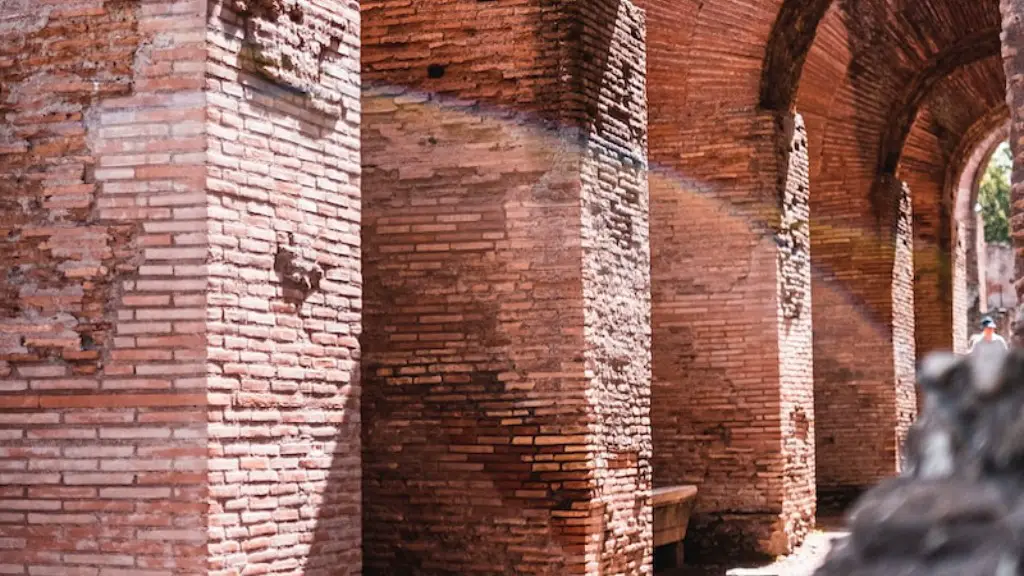Necklaces have been around for millennia, with the earliest ornamental necklaces dating back to ancient cultures, including the highly advanced civilization of Rome. Necklaces from ancient Rome were often made from different materials, including metal, stone and organic materials like ivory.
Rome was known for its craftsmanship, and its jewelry was highly advanced. During Roman times, jewelry was worn by royalty, wealthy people and even commoners. The most common materials used to make necklaces at this time were gold and silver, which were often intricately decorated. Gold was the most desirable material and the most valuable, so it was only worn by the wealthiest people. Silver was more affordable and could be found in the jewelry of all classes.
Gemstones were a highly sought-after material in Roman times, and many necklaces incorporated rare and precious stones. These stones were often set into decorative patterns, or cut into various shapes. The most popular stones were lapis lazuli, carnelian, and onyx. These materials were often found in the most expensive necklaces, and were often seen as a sign of wealth and prestige.
Ivory was another popular material used in Roman jewelry. Ancient Romans loved decorating themselves with items made from Ivory, such as combs and buckles. Necklaces were no exception, and their design often featured intricate carvings and designs. Ivory was also often paired with gemstones, giving the pieces a luxurious finish.
Glass beads were used to decorate many Roman jewelry pieces, including necklaces. These beads were often brightly colored and could be found in a wide variety of shapes and sizes. The Romans were skilled at crafting intricate pieces that incorporated glass beads, and the most expensive necklaces often featured glass inlayed with precious stones.
Necklaces from ancient Rome vary in style and material. Many pieces are still available, providing a rare insight into the fashion and craftsmanship of this advanced civilization. For the modern-day collector, these pieces provide a glimpse into a long-lost culture, and a chance to own a piece of history.
Designs
Necklaces from ancient Rome varied in style and design. Popular designs included snake-shaped and fish-shaped necklaces, often made from gold or silver and sometimes set with gemstones. Roman necklaces could also be simple flat pieces made of metal, or intricate pieces inlaid with enamels and glass.
One of the most popular designs from the Roman period was a necklace in the shape of a wheel. This type of necklace was often crafted from gold and featured tiny inlaid stones. It was a popular choice among the wealthy, as it symbolized wealth and prosperity.
A fascinating type of necklace worn by Roman women was the torc necklace. These necklaces were often made from gold and featured intricate knotwork designs. They were seen as a sign of status, and wealthy women would often have multiple torc necklaces in varying sizes and designs.
Cross necklaces were also popular during the Roman Empire. These necklaces were symbolic of Christian beliefs, and could be made from a variety of materials, including gold, silver and even bone. Cross necklaces were often decorated with precious stones and enamels, and were seen as a status symbol.
Necklaces from this era could also feature deities and symbols from Roman mythology. Some of the most popular symbols included gods, goddesses and monsters. These necklaces were often made from gold and set with precious stones, and were seen as a way to show devotion to the gods.
Craftsmanship
The craftsmanship of necklaces from ancient Rome was highly advanced. Roman craftsmanship was renowned for its skill and intricacy, and many pieces featured enamels and glass inlaid with precious stones. Roman artisans could craft jewelry with a remarkable level of detail and intricacy, and this skill has been celebrated for centuries.
The Romans were also skilled in the art of casting, and would often cast necklaces in gold and silver. This process allowed for intricate patterns and designs to be created, and for jewelry to be made with a level of detail that was not achievable with manual craftsmanship.
Inlaying gems and stones was also a popular technique during the Roman period. Many necklaces featured intricate inlays of precious stones and glass, and this technique was used to create beautiful and unique pieces. It was also seen as a sign of wealth and prestige, as only those with the finances to purchase such items could wear them.
The techniques used by Roman jewelers have been studied for centuries, and their skill and craftsmanship remain unmatched. Necklaces from ancient Rome are incredibly intricate and beautiful, and are highly sought-after by collectors and historians alike.
Significance
Necklaces from ancient Rome were highly symbolic and held deep personal significance for their wearers. For example, the Romans believed that wearing a fish-shaped necklace was a sign of fertility, and that it could help protect the wearer from evil. Roman women also believed that wearing a necklace could bring them good luck, and it was common for women to wear necklaces featuring gods and goddesses from Roman mythology.
Necklaces from this period were also seen as an indicator of wealth and status, as the most intricate and expensive pieces were only worn by the wealthy. The materials and techniques used to craft these pieces were also highly symbolic, and many items featured intricate inlays and carvings that hinted at the wearer’s prestige.
Today, necklaces from ancient Rome are a popular choice for collectors of historical jewelry. These pieces represent an important part of history, and they allow us to appreciate the skill and craftsmanship of a long-lost civilization. For the modern-day collector, these pieces provide a rare glimpse into a lost culture and artistry, making them a valuable addition to any collection.
Export
Necklaces from ancient Rome were often exported to other parts of the world, and the Romans were highly successful in exporting their jewelry. The Romans were able to trade their jewelry with cultures all around the Mediterranean, and were able to introduce their craftsmanship and techniques to other civilizations. This allowed the Romans to spread their culture and influence, as well as providing them with access to valuable materials from other parts of the world.
The Romans also traded with Northern Europe, and necklaces from ancient Rome have been found in many countries, including Britain. This trade helped to spread the Roman style of jewelry across many different cultures, and this influence can still be seen in many countries today.
Exporting Roman jewelry was an important part of the Roman economy, and this trade helped to generate wealth and prosperity. It also provided a valuable source of income, as well as allowing artisans to showcase their skills and craftsmanship to the wider world.
Today, necklaces from ancient Rome remain highly sought-after and provide a rare insight into an advanced civilization. These pieces are a valuable addition to any historical collection and offer a glimpse into an ancient culture that has long since passed.
Symbolism
Necklaces from ancient Rome were highly symbolic, and many pieces featured gods, goddesses, and symbols from Roman mythology. These symbols were often symbolic of protection, prosperity and fertility, and were seen as a way for the Romans to show their devotion to the gods. Popular symbols included the god Jupiter, whose symbol was a lightning bolt, and the goddess Venus, whose symbol was a star.
Crosses were also a popular symbol, and cross necklaces were often seen as a sign of faith and piety. Wealthy Romans would often adorn themselves with crosses made from gold and set with precious stones. This was seen as a sign of devotion to the gods, and could also be seen as a way to ward off evil.
Many Roman necklaces also featured symbols of fertility, such as snake-shaped and fish-shaped pieces. The Romans believed that wearing these symbols could help protect the wearer from evil and bring them good luck. Roman women were often seen wearing these symbols, as it was thought to bring them health and fertility.
Symbols from Roman mythology were highly sought-after, and many of these pieces are still available today. Roman necklaces featuring symbols and gods are highly collectible and offer a unique insight into the beliefs and customs of a long-lost civilization.
Conclusion
Necklaces from ancient Rome are an important part of history, offering a rare insight into an advanced civilization. These precious pieces were often crafted from gold and silver, as well as gemstones, ivory, and glass. They were highly symbolic and were often decorated with gods and goddesses from Roman mythology, or with symbols of fertility and protection.
The craftsmanship of Roman jewelers was highly advanced, and their skill and intricacy remain unmatched. Necklaces from this period often featured intricate inlays and carvings, and many pieces are still available today. For the modern-day collector, these pieces provide a glimpse into a long-lost culture and artistry, making them a valuable addition to any collection.





